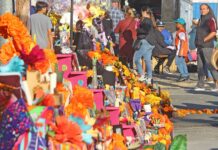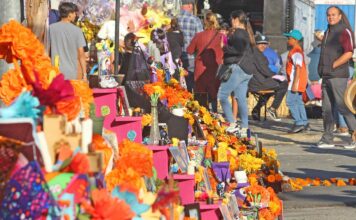In the Garlic Festival’s second year, Bill Ayer kept a
promise
– sort of – to eat his hat. While helping to organize the first
festival that took place in 1979, he said he didn’t think
attendance would surpass 5,000. Much to everyone’s surprise, it
went over 15,000 guests.
In the Garlic Festival’s second year, Bill Ayer kept a promise – sort of – to eat his hat. While helping to organize the first festival that took place in 1979, he said he didn’t think attendance would surpass 5,000. Much to everyone’s surprise, it went over 15,000 guests.
“I said I’ll eat my hat if we get more than 5,000,” he said. “So they made me a chocolate cake ‘hat’ which I had to eat. It was a pleasure.
“The festival has been a great experience for me. I feel really fortunate that I’ve been able to be involved with the festival because it’s done so well.”
In the festival’s second year, Ayer, as director of Gilroy’s Park and Recreation Department, played a big role in moving the culinary event to Christmas Hill Park, a much better facility than the dusty field at the original Bloomfield Ranch site where Highway 25 meets U.S. 101.
In 1981, the third year of the festival, Ayer served as president. He has volunteered in some way at the event every year since the beginning days. In recent years, he can often be found selling wine at the Rotary Club’s booth during the festival.
“Any place I go in the world, I tell them I’m from Gilroy and they say, ‘Oh, the Garlic Capital,’ ” he said. “It turned Gilroy around – gave it identification. Once the Garlic Festival happened, the town’s people started to gain some pride in themselves and pride in the city.”
He remembers working closely with Rudy Melone, the festival founder, during those hectic pioneer days when the concept of the Garlic Festival was still brand new and rapidly evolving
“Rudy was a heck of a guy. He was the inspiration of this thing,” Ayer said. “He came from Portland, Ore., which has the famous Rose Festival. It’s a big source of community pride for Portland. He wanted to try something similar for Gilroy.”
Ayer served as the logistics chairman of the first two festivals. He remembers organizing the facilities as a learning experience that paved the way for festival success.
“Logistics was everything,” he said. “It was parking, water, power, restrooms, security, loading all the stuff and getting it there. It was a comedy of errors that first year. It was trying to put together all the ingredients of the festival. We really didn’t know what would happen until we got all the ingredients together.”
Moving the festival to Christmas Hill Park in its second year caused some controversy. Some thought it improper to take the use of the park from residents for three days.
“I was trying to get the parks to be the centerpiece of Gilroy life at the time,” he said. “I thought it was a good idea to bring the festival there.”
The third year of the festival attracted about 90,000 people, four times the number in the first festival year.
“At that time we didn’t have the Ranch Site,” Ayer recalls. “Everything was contained at Christmas Hill Park’s original site. It was a jam. I remember running out of everything from restrooms to peppers for pepper steak sandwiches.”
Ayer retired from the Parks and Recreation Department in 1987. He still keeps active with golf and volunteering for the Rotary and the Gilroy Foundation. He enjoys working on the Strategic Planning Committee of past presidents who offer advice in the direction the festival should go.
He also takes pride in the impact the festival he helped create has had.
“Gilroy is a nice little community to live in,” he said. “When you live here for a while, you get to know there’s a lot of community pride and a lot of connectedness. And one of the things that helped create that community pride is the festival.”













